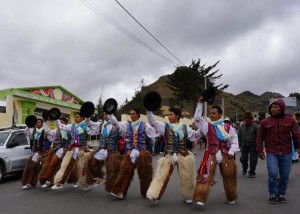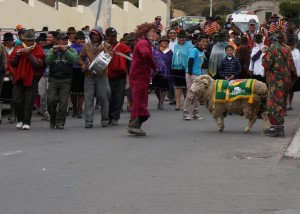At the Zumbagua parish fiesta, July 5, 2014, the members of the tourist trade association of Quilotoa accompanied a lady, a fox, a ram and a four man band to the join the parade in Zumbagua. They were a hit among the thousands who gathered, spectators and fellow parade participants alike, many of whom tracked the ensemble at arm’s length with their cellphone video cameras. The “lady” was a crossed dressed man, a scoundrel who put on a rubber mask of a white woman with a tangle of auburn locks and a cigarette dangling from her mouth. She toted along a loosely swaddled doll that was constantly put into peril.
 The “fox” was a masked man wearing a one piece clown suit and a carved wooden mask. The ram was a ram. Big and wooly and festooned with a green blanket proclaiming the formal name of the trade association.
The “fox” was a masked man wearing a one piece clown suit and a carved wooden mask. The ram was a ram. Big and wooly and festooned with a green blanket proclaiming the formal name of the trade association.
As good a show as this ensemble was, it was also a mess. Community leaders had got into a fight over whether to use a bus or a caravan of pick-ups to transport everyone down from Quilotoa. After finally sorting things out, the ensemble of residents, band and costumed protagonists arrived late to the staging area. They found a place– the second to last group –following over thirty schools, town groups and a credit union from across the parish. Where others twirled down the route in synchronized moves, the Quilotoans shambled along. And, the lady was a kleptomaniac, lifting skewers of meat, cotton candy, Orange Fanta and even eggs from street sellers who crossed paths with her, handing them off to her wife or simply tying the loot to the ram. Her brazenness drew wide-eyed wonder from young witnesses.
As the parade wended its way along, most Quilotoans got bored and slipped off into the market. By the time the Quilotoans arrived at the stand of politicians, perhaps five remained with the Lady, the Fox and the ram, and two of us were anthropologists, Joe Quick, a graduate student from the University of Wisconsin- Madison (who had been patiently filming much of the parade) and me (who was getting as distracted and prone to wandering off as some Quilotoans). Another was a disheartened young man who complained that the whole presentation of the association was badly done. “In 2006, the council organized things; we put on dances and won prizes at the fiesta. Now, nothing.”
Yet in all of the parade, this group that represented the “Centro Turistico Quilotoa,” was the only one marching as a community, not a school or a savings coop or dedicated parade unit like the assembled team of horsemen. Quilotoa, essentially a collectivity of tourist entrepreneurs, mustered its members where the scores of peasant comunas in the parish stayed home.
Why do some trades come together as a community package of territory, cultural identity and economic assets? I had been spending time in Quilotoa, working with Joe Quick, Angélica Ordoñez (from the Universidad San Francisco-Quito) and others to work on that question. Across the political spectrum, state authorities and activists have touted this kind of convergence as place-based development. In Latin America, pro-market, neoliberal reformers encouraged the growth of geographically defined business clusters. They argued the co-location of producers in the same market niche would develop and sustain a skilled labor force, attract suppliers, and build a city’s reputation for competitiveness internationally. The opposition embraced place and development, too. The fight against globalization defended indigenous ancestral territories, promoted community-managed fields and water rights, and backed heritage foods, the taste of place, and regional craft enterprises.
Currently in rural Latin America, the strongest application of these ideas is in communities that earn from heritage-based tourism. While this is especially true where thousands of visitors are drawn by UNESCO world heritage designations, communities also gain from more modest national promotions, including state-protected artisanal practices and new eco-tourism hotspots. Yet the idea is spreading, as factory towns, bustling weekly markets, and artisanal mining trades have also been tapped by the state for their potential to profitably blend place, identity and economy.
For all of their heritage or co-located resources, geographically-bound economies often falter. Based on what we are finding out in Quilotoa, we argue that the success of a place-based economy is a phase of community life, less tied to features of a location or the depths of tradition than to rivalries within and between communities. That is, a trade may start as idiosyncratic entrepreneurial activity, then draw a critical mass of local residents into its work, and consolidate into a claim about community tradition. This sequence succeeds, though, not for the way it recovers or develops some special fusion of tradition, product and place. Rather it tracks a series of conflicts among rival business operators, with outsiders, or in opposition to state regulators.
The generative tie between conflict and economy is what comes to mind when I think of the fiesta presentation of the tourist association of Quilotoa–the lady, the fox and the ram. The Quilotoa procession arrived at the parish’s main stage a diminished bunch by standards of past performances. They could show off no rehearsed dance moves and they enjoyed almost no accompaniment from the rest of the membership by the time they were face to face with all the dignitaries. More subtly, the lack of counterparts from other communities, the fact that no neighboring peasant sector bothered to march cast the Quilotoans as a kind of oddity. The rest of the parade was composed of orderly, marching high school kids or dance troops sponsored by savings coops. These capering Quilotoans were out-of-place. If Quilotoa had built its authority within the community and across the parish by taking on rivals, it was no longer clear who they sparred with. It seemed as if their association’s moment now passed.
And yet, here they were, the lady, the fox and the ram, prancing to the end of the parade. They arrived in a dust-up over a bus that pitted the current president against longtime aspirant for leadership. Then the lady and the fox spent three mischievous hours rudely playing by their own rules, stealing little items, teasing bystanders and fellow parade marchers alike. An unfocused scrappiness bubbled up all morning long. It showed a community that still had its binding energy, its fighting spirit that can link up work, place and people up on the rim of the crater.



